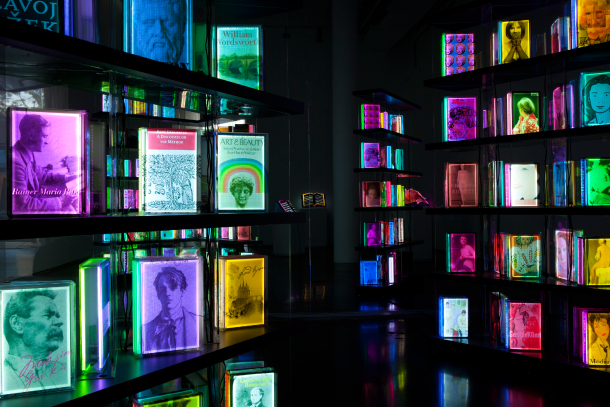The power of dreams to propel people’s lives: Exhibit highlights the stories that shape children as they grow

Kang Ai-ran’s “Lighting Books” are life-sized books that shine with light-emitting diodes placed inside of them, symbolizing the bright ideas and stories that exist inside books that we read. [GYEONGGI MUSEUM OF MODERN ART]
The exhibition uses books to introduce stories and dreams expressed by the eight artists participating in the exhibit: Hong Kyoung-tack, Kang Ai-ran, Kang Yo-bae, Noh Seok-mee, Lee Lee-nam, teamVOID, Nam June Paik and Kang Ik-joong.
Hong Kyoung-tack’s oil painting “Library - The Moment Doves Fly” (2016) opens the exhibition with a peaceful, yet mysterious, scene of a library in which a young boy sits among books, flying doves, mushrooms on wooden shelves and even a skull sitting on the stool. The boy in the painting is his nephew, but the library is a fictitious space that Hong created. He was inspired by a small book shop he visited in New York.
“Libraries are almost like sanctuaries,” Hong told local press on Oct. 24. “It’s a place of privacy, like a cave of one’s own. It’s a fountain of knowledge, art and life. The library that I painted isn’t a real place, but a conceptual one. I was able to give it more depth to express it differently from the other libraries we know, and thereby create a space that contains all these symbols and many more within.”
Hong’s works are followed by Kang Ai-ran’s “Lighting Books,” which are a part of her “Digital Book” project that she has carried on since 2010. The light-emitting diode (LED) lighting inside each book illuminates the books against a black backdrop, symbolizing the bright ideas and new worlds people encounter as they turn each page.

Above, Lee Lee-nam’s “New Mongyoudowondo,” is an video art piece, reinterpretating Mongyudowondo (1447) (“Scenery in Dream”) by Joseon (1392-1910) artist An Kyon, which allows people to see impossible moments through art. At left is artist Kang Ik-joong’s “Wall of Hope,” which the artist created along with 50,000 children who each created a tile drawing of their dreams. [GYEONGGI MUSEUM OF MODERN ART]
Paik’s “rabbit inhabits the Moon” (1996) sits in front of Kang Ik-joong’s “Moon Jar, Red and Blue” which finishes off the exhibit. The gigantic jar on canvas is made the same way as all his other moons - fired in a kiln. For this piece, he created the upper and the lower part separately, one in red and one in blue to symbolize the Korean flag, and then put the two together as symbol of harmony.
“Just as we hope North and South Korea become unified soon, the moon jar is a symbol of our country, the yin and the yang, life and death, and future and past. By connecting two different things together into one, a new story is born,” said Kang Ik-joong.
The “Wall of Hope” is also by Kang. His similar works that feature 3-inch tiles completed by thousands of people have earned worldwide acclaim, including “Amazed World” (2001), “Bridge of Dream” (2013) and “Floating Dreams” (2016). Among the 50,000 tiles drawn by each child at GMMA, there used to be toys and objects that belonged to some of the children. The museum removed the objects and replaced them with 2,000 3-inch mono jar tiles, and installed neon signs of children blowing bubbles.

“We took the chance to talk to some of the people who took part in the project,” said Choi Hye-kyoung who curated the exhibition. “Back then, there were just two children in Gapa Elementary School, the southern-most school in Korea, and they were both in the project. One of them just went to the Army for his military service. The other one wanted to become an artist when she was younger, and she’s become an animator now.”
“I used to dream of being in a place surrounded by books and just reading all day,” said Choi Eun-ju, director of GMMA.
“That dream has come alive with this exhibition. All these works shed light on the idea of dreams and show that the different stories are different ways in which we live our lives. This exhibition makes us realize that.”
BY YOON SO-YEON [yoon.soyeon@joongang.co.kr]










with the Korea JoongAng Daily
To write comments, please log in to one of the accounts.
Standards Board Policy (0/250자)